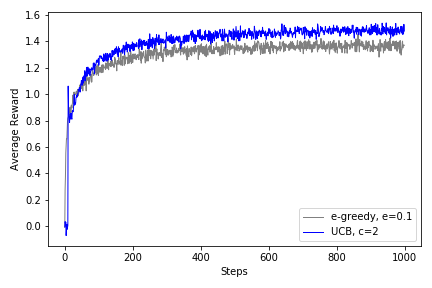Upper-Confidence-Bound (UCB) Bandit is the same as Simple Bandit but with different $A$ selection rule. See book equation (2.10). UCB is used e.g. in AlphaZero algorithm.
$$ A_t \doteq \mathop{\text{argmax}}_a \big[ Q_t(a) + c \sqrt{\frac{\ln{t}}{N_t(a)}} \big] $$In [1]:
def ucb_bandit(env, nb, c):
Q = np.zeros(env.size)
N = np.zeros(env.size)
hist_A = []
hist_R = []
# select each action at lest once
for A in range(env.size):
R = env.step(A)
N[A] += 1
Q[A] += (1/N[A]) * (R - Q[A])
hist_A.append(A)
hist_R.append(R)
for t in range(env.size, nb):
A = argmax_rand( Q + c * np.sqrt( np.log(t) / N ) )
R = env.step(A)
N[A] += 1
Q[A] += (1/N[A]) * (R - Q[A])
hist_A.append(A)
hist_R.append(R)
return Q, np.array(hist_A), np.array(hist_R)
Helper functions:
In [2]:
def argmax_rand(arr):
# break ties randomly, np.argmax() always picks first max
return np.random.choice(np.flatnonzero(arr == arr.max()))
 |
Experiment Setup¶
In [3]:
import numpy as np
import matplotlib.pyplot as plt
Environment
In [4]:
class BanditEnv:
def __init__(self):
"""10-armed testbed, see chapter 2.3"""
self.size = 10 # 10 arms
self.means = np.random.normal(loc=0.0, scale=1.0, size=self.size)
def step(self, action):
return np.random.normal(loc=self.means[action])
Recreate Figure 2.4¶
Simple bandit for comparison
In [5]:
def simple_bandit(env, nb, eps):
Q = np.zeros(env.size)
N = np.zeros(env.size)
hist_A = []
hist_R = []
for _ in range(nb):
A = argmax_rand(Q) if np.random.rand() > eps else np.random.randint(env.size)
R = env.step(A)
N[A] += 1
Q[A] += (1/N[A]) * (R - Q[A])
hist_A.append(A)
hist_R.append(R)
return Q, np.array(hist_A), np.array(hist_R)
Generate raw data
In [6]:
runs_ep01_R = []
runs_ucb1_R = []
print('v' + ' '*18 + 'v') # poor man tqdm
for i in range(2000):
env = BanditEnv()
_, _, hist_R = simple_bandit(env, nb=1000, eps=0.1)
runs_ep01_R.append(hist_R)
_, _, hist_R = ucb_bandit(env, nb=1000, c=2.0)
runs_ucb1_R.append(hist_R)
if i % 100 == 0: print('.', end='')
runs_ep01_R = np.array(runs_ep01_R)
runs_ucb1_R = np.array(runs_ucb1_R)
Calculate average reward
In [7]:
# Calc average reward
avg_ep01_R = np.average(runs_ep01_R, axis=0)
avg_ucb1_R = np.average(runs_ucb1_R, axis=0)
Plot the plots
In [8]:
fig = plt.figure()
ax = fig.add_subplot(111)
ax.plot(avg_ep01_R, linewidth=1., color='gray', label='e-greedy, e=0.1')
ax.plot(avg_ucb1_R, linewidth=1., color='blue', label='UCB, c=2')
ax.set_xlabel('Steps'); ax.set_ylabel('Average Reward')
ax.legend()
plt.tight_layout()
plt.savefig('assets/fig_0204.png')
plt.show()